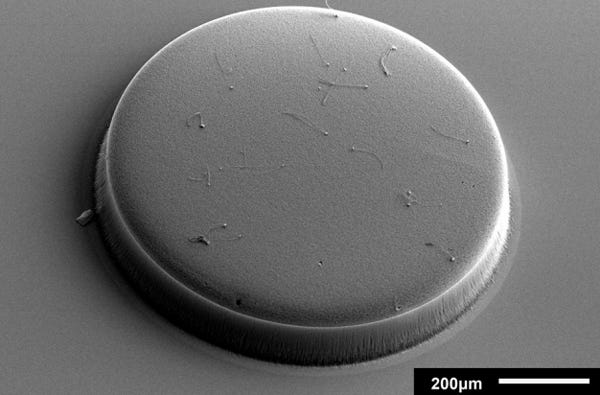December 22, 2015
MIT engineers think the nanotube coatings could be used to trap hard-to-detect molecules.
Qmed Staff
|
The patterned and cylindrical structure is comprised of carbon nanotubes. (Image courtesy of MIT) |
A coating made of "forests" of carbon and nanotubes can be engineered to trap certain particles, providing the potential to finely tune microfluidic devices to detect extremely small and rare viruses and proteins, according to new research out of MIT.
"There are smaller bioparticles that contain very rich amounts of information that we don't currently have the ability to access in point-of-care [medical testing] devices like microfluidic chips," Brian Wardle, MIT professor of aeronautics and astronautics, said in a university news release.
"Carbon nanotube arrays could actually be a platform that could target that size of bioparticle," said Wardle, who is co-author of a new paper in the Journal of Microsystems and Nanoengineering about the research.
The MIT researchers were able to demonstrate this by applying an established technique in which they treated the surface of the nanotubes with antibodies that bind to prostate specific antigen, which is a common experimental target. The polymer-coated arrays were able to capture 40% more antigens, compared with arrays lacking the polymer coating.
The MIT team was able to achieve such results because they coated the nanotube array, layer by layer, with polymers of alternating electric charge.
"You can think of each nanotube in the forest as being concentrically coated with different layers of polymer," Wardle said. "If you drew it in cross-section, it would be like rings on a tree."
Researchers used the layers to create thicker or thinner nanotubes and thereby tailor the porosity of the forest to capture larger or smaller particles of interest.
MIT shared more about how the three-dimensional carbon nanotube array was integrated into a microfluidic device: Researchers used chemical vapor deposition to grow and pattern the nanotubes onto silicon wafers, with the nanotubes then grouped into a cylinder-shaped forest, about 50 ?m tall, 1 mm wide, and centered within a 3 mm-wide, 7-mm long microfluidic channel.
Wardle and colleagues were able to coat the nanotubes by flowing successive layers of alternately charged polymer solutions through the channels. They were able to coat more uniformly by creating a gap between the top of the nanotube forest and the roof of the channel.
The nanotube array could prove to be extremely versatile, according to Wardle. It is possible to manipulate the carbon nanotubes mechanically, electrically, and optically, and the polymer coatings could chemically altered in order to capture a wide range of particles.
Such an array, for example could be useful capturing biomarkers called exosomes. Less than 100 nm wide, exomes can be important signals of a disease's progression, according to Wardle.
"This type of device actually has all the characteristics and functionality that would allow you to go after bioparticles like exosomes and things that really truly are nanometer scale," Wardle said.
Learn more about cutting-edge medical devices at MD&M West, February 9-11 at the Anaheim Convention Center in Anaheim, CA. |
Chris Newmarker is senior editor of Qmed and MPMN. Follow him on Twitter at @newmarker.
Like what you're reading? Subscribe to our daily e-newsletter.
About the Author(s)
You May Also Like



.png?width=300&auto=webp&quality=80&disable=upscale)